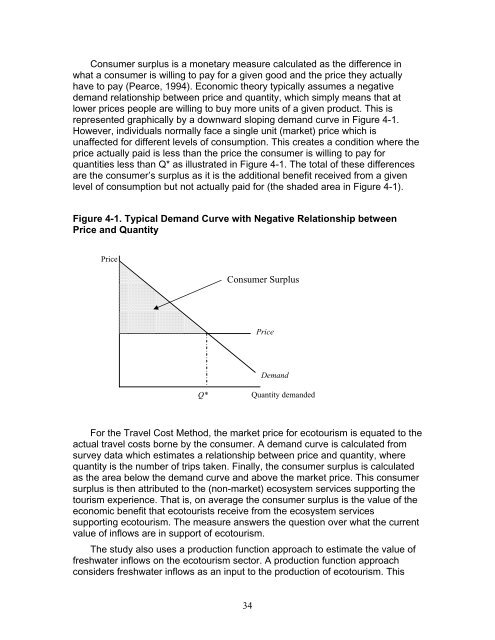The Economic Value of Water and Ecosystem Preservation
The Economic Value of Water and Ecosystem Preservation
The Economic Value of Water and Ecosystem Preservation
You also want an ePaper? Increase the reach of your titles
YUMPU automatically turns print PDFs into web optimized ePapers that Google loves.
Consumer surplus is a monetary measure calculated as the difference in<br />
what a consumer is willing to pay for a given good <strong>and</strong> the price they actually<br />
have to pay (Pearce, 1994). <strong>Economic</strong> theory typically assumes a negative<br />
dem<strong>and</strong> relationship between price <strong>and</strong> quantity, which simply means that at<br />
lower prices people are willing to buy more units <strong>of</strong> a given product. This is<br />
represented graphically by a downward sloping dem<strong>and</strong> curve in Figure 4-1.<br />
However, individuals normally face a single unit (market) price which is<br />
unaffected for different levels <strong>of</strong> consumption. This creates a condition where the<br />
price actually paid is less than the price the consumer is willing to pay for<br />
quantities less than Q* as illustrated in Figure 4-1. <strong>The</strong> total <strong>of</strong> these differences<br />
are the consumer’s surplus as it is the additional benefit received from a given<br />
level <strong>of</strong> consumption but not actually paid for (the shaded area in Figure 4-1).<br />
Figure 4-1. Typical Dem<strong>and</strong> Curve with Negative Relationship between<br />
Price <strong>and</strong> Quantity<br />
Price<br />
Q*<br />
Consumer Surplus<br />
For the Travel Cost Method, the market price for ecotourism is equated to the<br />
actual travel costs borne by the consumer. A dem<strong>and</strong> curve is calculated from<br />
survey data which estimates a relationship between price <strong>and</strong> quantity, where<br />
quantity is the number <strong>of</strong> trips taken. Finally, the consumer surplus is calculated<br />
as the area below the dem<strong>and</strong> curve <strong>and</strong> above the market price. This consumer<br />
surplus is then attributed to the (non-market) ecosystem services supporting the<br />
tourism experience. That is, on average the consumer surplus is the value <strong>of</strong> the<br />
economic benefit that ecotourists receive from the ecosystem services<br />
supporting ecotourism. <strong>The</strong> measure answers the question over what the current<br />
value <strong>of</strong> inflows are in support <strong>of</strong> ecotourism.<br />
<strong>The</strong> study also uses a production function approach to estimate the value <strong>of</strong><br />
freshwater inflows on the ecotourism sector. A production function approach<br />
considers freshwater inflows as an input to the production <strong>of</strong> ecotourism. This<br />
34<br />
Price<br />
Dem<strong>and</strong><br />
Quantity dem<strong>and</strong>ed
















